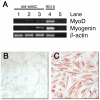Term Amniotic membrane is a high throughput source for multipotent Mesenchymal Stem Cells with the ability to differentiate into endothelial cells in vitro
- PMID: 17313666
- PMCID: PMC1810523
- DOI: 10.1186/1471-213X-7-11
Term Amniotic membrane is a high throughput source for multipotent Mesenchymal Stem Cells with the ability to differentiate into endothelial cells in vitro
Abstract
Background: Term Amniotic membrane (AM) is a very attractive source of Mesenchymal Stem Cells (MSCs) due to the fact that this fetal tissue is usually discarded without ethical conflicts, leading to high efficiency in MSC recovery with no intrusive procedures. Here we confirmed that term AM, as previously reported in the literature, is an abundant source of hMSCs; in particular we further investigated the AM differentiation potential by assessing whether these cells may also be committed to the angiogenic fate. In agreement with the recommendation of the International Society for Cellular Therapy, the mesenchymal cells herein investigated were named Amniotic Membrane-human Mesenchymal Stromal Cells (AM-hMSC).
Results: The recovery of hMSCs and their in vitro expansion potential were greater in amniotic membrane than in bone marrow stroma. At flow cytometry analysis AM-hMSCs showed an immunophenotypical profile, i.e., positive for CD105, CD73, CD29, CD44, CD166 and negative for CD14, CD34, CD45, consistent with that reported for bone marrow-derived MSCs. In addition, amniotic membrane-isolated cells underwent in vitro osteogenic (von Kossa stain), adipogenic (Oil Red-O stain), chondrogenic (collagen type II immunohistochemichal detection) and myogenic (RT-PCR MyoD and Myogenin expression as well as desmin immunohistochemical detection) differentiation. In angiogenic experiments, a spontaneous differentiation into endothelial cells was detected by in vitro matrigel assay and this behaviour has been enhanced through Vascular Endothelial Growth Factor (VEGF) induction. According to these findings, VEGF receptor 1 and 2 (FLT-1 and KDR) were basally expressed in AM-hMSCs and the expression of endothelial-specific markers like FLT-1 KDR, ICAM-1 increased after exposure to VEGF together with the occurrence of CD34 and von Willebrand Factor positive cells.
Conclusion: The current study suggests that AM-hMSCs may emerge as a remarkable tool for the cell therapy of multiple diseased tissues. AM-hMSCs may potentially assist both bone and cartilage repair, nevertheless, due to their angiogenic potential, they may also pave the way for novel approaches in the development of tissue-engineered vascular grafts which are useful when vascularization of ischemic tissues is required.
Figures









References
Publication types
MeSH terms
LinkOut - more resources
Full Text Sources
Other Literature Sources
Research Materials
Miscellaneous

